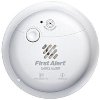
Iowa Dual Sensor Rule Now Set for April 1
The upcoming rule from the State Fire Marshal requiring dual sensor smoke detectors affects new homes, dormitories, and multi-unit residential buildings.
Iowa's State Fire Marshal recently announced its upcoming administrative rules requiring dual sensor smoke detectors to be installed in all new residential construction will have an effective starting date of April 1, 2010, rather than the Oct. 1, 2009, date announced earlier. The requirement will affect new homes, dormitories (defined as a residential building or portion of a building at an educational institution which houses students in rooms not individually equipped with cooking facilities), and multi-unit residential buildings, including apartment houses or a portion of a building or an apartment house with two or more units; hotels; motels; and rooming houses.
The requirements are found in 661 Iowa Administrative Code Chapter 210. A dual sensor detector has a photoelectric sensor that protects best against slow, smoldering fires and an ionization sensor that protects best against fast, flaming fires.
The fire marshal's office has posted an FAQ page that advises homeowners they do not have to replace ionization or photoelectric smoke detectors in their homes if those units meet all manufacturers' recommendations. "However, when you have a detector that needs to be replaced, it must be replaced with a dual sensor detector," according to this guidance.
Detectors "other than dual sensor detectors" may be installed, and the fire marshal's office explains them this way: "If the conditions of the smoke detector requirements are met with dual sensor detectors, additional detectors may be added, such as a combination smoke/CO detector, or a smoke detector that has a strobe light for the hearing impaired. But remember, dual sensor detectors first!"